I try to write my posts as unbiased as possible and recommend the products I consider to be useful and the best. I use affiliate links, this means that–at no extra cost to you–I can make a commission on a purchase you make after clicking on them. As an Amazon Associate I earn from qualifying purchases.
Basic Dog Body Language of Fearful Dogs
Basic dog body language will help you detect a fearful dog and take the threat away to calm him. Fear in dogs is the number one cause of aggression and they signal with different parts of their body to make the threat go away.
Dogs communicate with their body and every dog owner or pet professional should be able to read when a dog is afraid. Dogs can be afraid of many things: other dogs, people, sounds, strange objects, etc. They will display fearful body language signals to anything they consider a threat in the hopes that the threat goes away.
If you can see that a dog is fearful, you should move away from the dog and/or take your dog away from it. If you see that your dog is the fearful one, you should take him away from that situation. Never force your dog to interact with something that frightens him.
The key to understanding basic dog body language is to always read the entire body of the dog. Do not get fooled by thinking that because a dog is wagging his tail he will be friendly.
Basic Dog Body Language of Fearful Dogs
"An animal's eyes have the power to speak a great language."
Martin Buber
In the canine world eye contact can be threatening. This doesn't' mean you can't make eye contact with your best friend, in fact you can teach him to make eye contact on command!
The important thing to know is that you should NEVER be threatening when looking into your dog's eyes. There are two types of eye contact: soft and hard.
 Eye contact with soft eyes: Eyes are round and peaceful. This means the dog is calm and happy. |
 Eye contact with a hard stare: Direct eye contact with a hard stare (tense body posture) means arousal. This can be good or bad! Make sure you look for other body signals to figure out if your dog is in a playful mood or about to show aggression. |
|
Whale eye: This happens when the dog is afraid to look at you, so he will actually turn his head the other way. At the same time he is not sure he should take his eyes off you, so with his head pointing away from you he will try to look at you! It is call a whale eye because you can see the white of their eyes. Dogs that have "whale eyes" are afraid and feel threatened. |
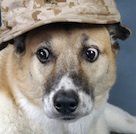 |
Fearful signals with the mouth
Basic dog body language of fearful dogs includes mouth displays from showing teeth to growling and snarling. However, you will see that there are many ways in which dogs can show their teeth and each one has a slightly different meaning.
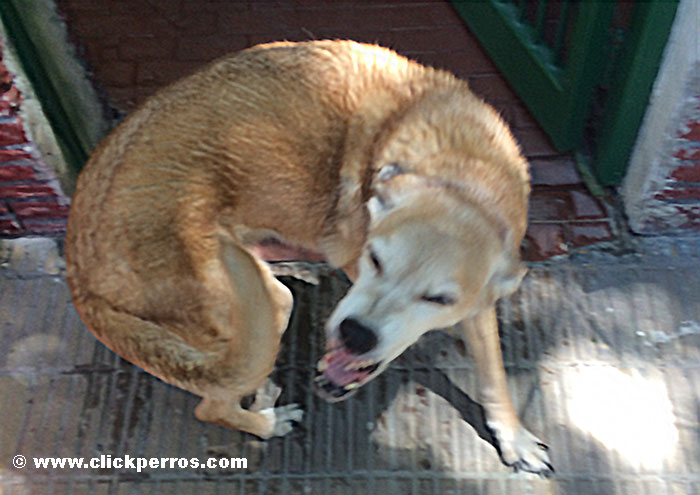 This is Naiko, he greets you at the door like this, showing ALL of his teeth. Notice though the tail tucked and eyes squinted, ears back.
This is Naiko, he greets you at the door like this, showing ALL of his teeth. Notice though the tail tucked and eyes squinted, ears back.- Lips stretched back as in a forced smile showing even the deeper teeth: This together with other body signals means the dog is fearful or submissive.
- Submissive grin: An exaggeration of the previous one will turn into what is called a submissive grin. This may look to the untrained eye like growling and teeth showing. The main difference is that the lips are stretched back (forced smile) instead of pulled forward (muzzle wrinkled).
|
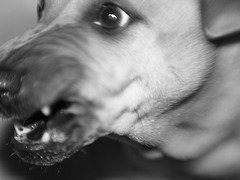 Image courtesy of k-pen |
Other basic dog body language of fearful dogs
Tell us what YOUR dog is saying!
- Freezing is one of the fearful postures you may see in any animal when afraid. It's a sudden stillness while standing, laying down or sitting.
- Body close to the ground: When a dog is trying to appear less taller and moving with his whole body close to the ground it communicates fear and submissiveness.
- Ears pinned backwards could mean submissiveness (check for other submissive signs) or fear (check for other signs of aggression and defensiveness).
- Low or tucked between the legs: This usually shows a fearful or submissive hound. The tail may be wagging or moving, this is just a signal that the dog is excited-anxious.
- Hackles raised: The hairs on the back of a dog may stand up for many reasons, it is, like a wagging tail, a signal that the dog is aroused. Some dogs play normally with their hackles raised. However, if you see other basic dog body language of fearful dogs separate them.
Dog tails under the microscope
A scientific study has shown that when dogs are really happy they will wag their tails a little bit more to the right. When they feel negative about something they are biased towards wagging their tails to the left!
The authors of this study propose an explanation based on the theory that the left side of the brain (which controls the right side of the body) has been link to positive feelings like love and attachment. On the other hand the right side of the brain (which controls the left side of the body) has been associated with fear and fleeing.
Put it all together!
Always look at the WHOLE body of a dog to determine his state of
mind. As you have learned a wagging tail is not always friendly and
showing teeth is not always a threat. Understanding basic dog body language is a great way to bond with your pooch.
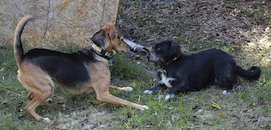 What are these dogs saying?
What are these dogs saying?During playtime dogs make lots of body signals. If you think your dog (or someone else's dos is afraid) the best thing to do is to hold the dog that is chasing for a few seconds and watch the dog that is being chased. If the dog come around and wants to keep playing, everything is fine. However if the dog takes this chance to escape and hide, he was not having fun.
Always make breaks during dog play, it is very easy for them to get over excited or for a fearful dog to start attacking because he will he has no escape.
Other articles in this series:
- Introduction to dog body language
- Basic body language of threats in dogs
- Calming and playful body signals
- How to help an aggressive fearful dog?
Home > Dog Behavior > Dog Body Language > Body Language of Fearful Dogs

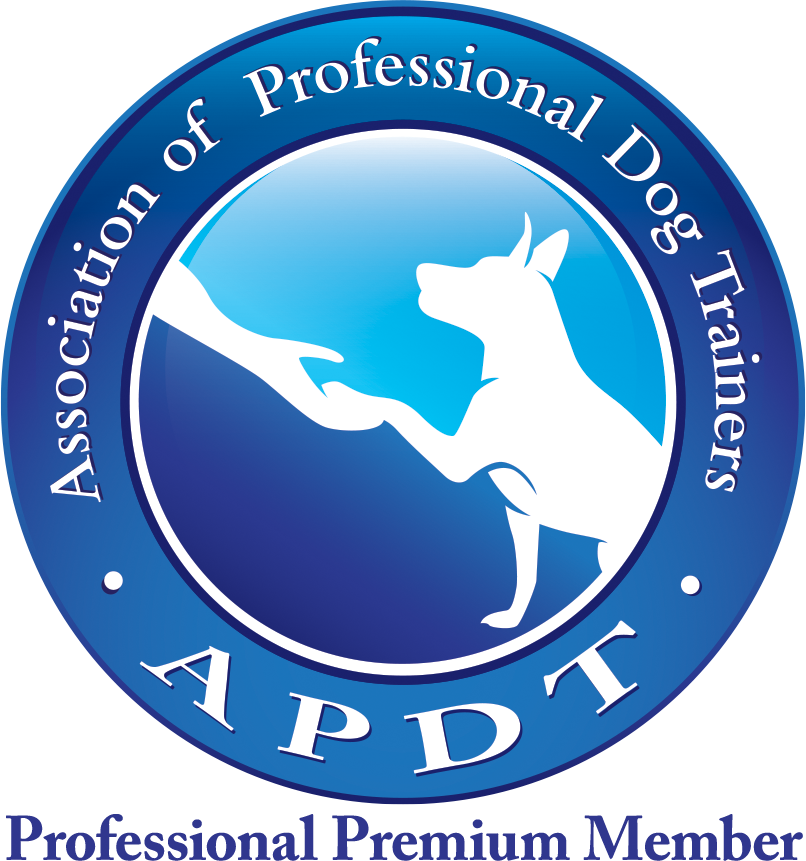


New! Comments
Questions? Anecdotes? Tips? Leave me a comment in the box below.